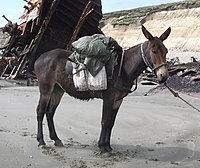
Photo from wikipedia
Wild relatives provide an important source of useful traits in wheat breeding. Wheat and wild relative hybrids have been widely used in breeding programs to introduce such traits into wheat.… Click to show full abstract
Wild relatives provide an important source of useful traits in wheat breeding. Wheat and wild relative hybrids have been widely used in breeding programs to introduce such traits into wheat. However, successful introgression is limited by the low frequency of homoeologous crossover (CO) between wheat and wild relative chromosomes. Hybrids between wheat carrying a 70 Mb deletion on chromosome 5B (ph1b) and wild relatives, have been exploited to increase the level of homoeologous CO, allowing chromosome exchange between their chromosomes. In ph1b-rye hybrids, CO number increases from a mean of 1 CO to 7 COs per cell. CO number can be further increased up to a mean of 12 COs per cell in these ph1b hybrids by treating the plants with Hoagland solution. More recently, it was shown that the major meiotic crossover gene ZIP4 on chromosome 5B (TaZIP4-B2) within the 70 Mb deletion, was responsible for the restriction of homoeologous COs in wheat-wild relative hybrids, confirming the ph1b phenotype as a complete Tazip4-B2 deletion mutant (Tazip4-B2 ph1b). In this study, we have identified the particular Hoagland solution constituent responsible for the increased chiasma frequency in Tazip4-B2 ph1b mutant-rye hybrids and extended the analysis to Tazip4-B2 TILLING and CRISPR mutant-Ae variabilis hybrids. Chiasma frequency at meiotic metaphase I, in the absence of each Hoagland solution macronutrient (NH4 H2PO4, KNO3, Ca (NO3)2·4H2O or Mg SO4·7H2O) was analyzed. A significant decrease in homoeologous CO frequency was observed when the Mg2+ ion was absent. A significant increase of homoeologous CO frequency was observed in all analyzed hybrids, when plants were irrigated with a 1 mM Mg2+ solution. These observations suggest a role for magnesium supplementation in improving the success of genetic material introgression from wild relatives into wheat.
Journal Title: Frontiers in Plant Science
Year Published: 2018
Link to full text (if available)
Share on Social Media: Sign Up to like & get
recommendations!